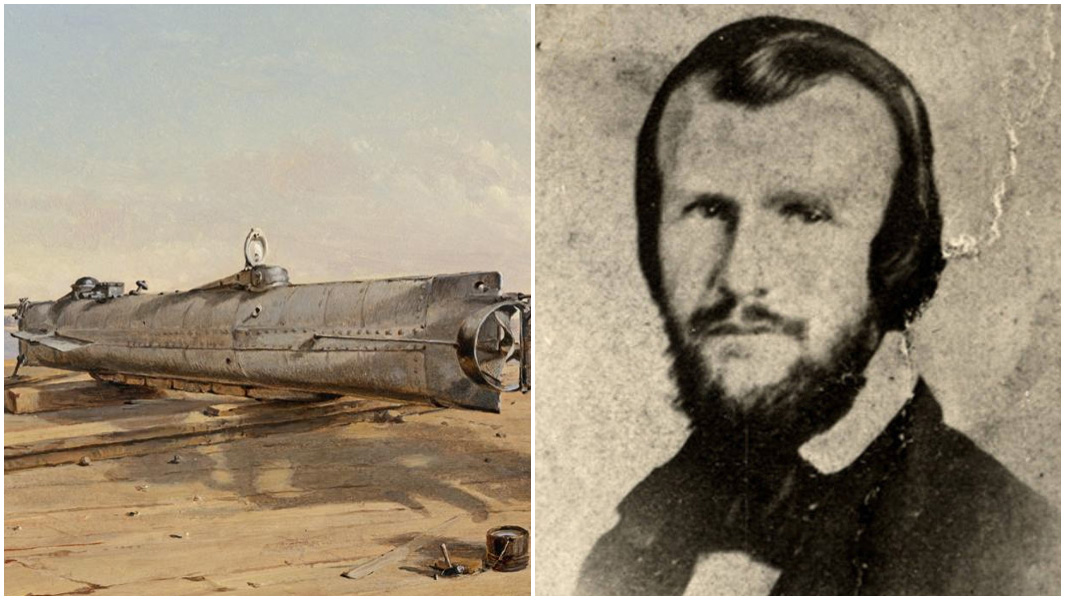The blundering Confederate submarine that sank itself three times

In a short career of less than seven months, the submarine H.L. Hunley sank three times.
Potentially the unluckiest boat in history – or the most incompetently run, given the self-inflicted nature of each sinking - it holds a record for the most times for a submarine to sink.
Designed by Horace Lawson Hunley, it was built in 1863 - the third year of the American Civil War - and belonged to the Confederacy.
However, the ill-fated vessel claimed more of its own crew’s lives than the enemy’s.
In total, 21 Confederate crewmen died aboard Hunley, in comparison to just five Union soldiers which it killed during its first and only real mission (after having already sunk twice!)

Measuring almost 12 m (40 ft) in length, the submarine was designed for an eight-man crew; seven to turn the hand-cranked propeller, and one to steer.
The claustrophobic interior of the hull was just 1.30 m (4 ft 3 in) in height. A watertight hatch was fitted at each end, although their small size made entering (and escaping) quite difficult.
In August 1863, following a demonstration in which it successfully attacked a non-military coal flatboat, Hunley was transported by rail to Charleston, South Carolina.
However, disaster struck just two weeks later, as the submarine sank during a test dive.
More accurately, it sank before the test dive, while running on the sea surface, due to the captain - Confederate Navy Lieutenant John A. Payne – accidentally stepping on a control lever which caused Hunley to dive with one hatch still open. Payne escaped along with two others, but the rest of the crew perished.

Hunley was salvaged by the Confederate Navy, however, less than two months later, she sank again during a training exercise.
This time all eight crewmen died, including the submarine’s inventor and namesake, Horace Lawson Hunley.
Once again, the submarine was salvaged and returned to service.

Three more months passed before the Hunley met misfortune for its third and final time.
It did so during its first combat mission, on 17 February 1864, where it successfully attacked the Housatonic, a US Navy warship. In doing so, it became the first combat submarine to sink an enemy ship.
Hunley’s weapon of choice was a ‘spar torpedo,’ comprised of a long wooden pole (the spar) attached to the submarine’s bow, at the end of which was a large copper cylinder containing explosive black powder (the torpedo).
Usually, spar torpedos had spiky barbs which were used to stick the explosive onto an enemy ship, allowing the attacker to move to safety before detonation.
However, archaeologists found that Hunley’s torpedo appeared to have no barbs and was designed to explode on contact at close range, meaning the submarine may have been less than 5 m (16 ft) from Housatonic when the torpedo exploded.

Interestingly, no signs of damage were found on Hunley’s hull. Inside, they discovered the skeletons of the crew, who were all seated at their stations and showed no signs of skeletal trauma.
Additionally, the keel blocks, which the crew could release from inside the hull in order to quickly surface, had never been released.
Given the close proximity of Hunley to its torpedo, in addition to the seemingly instantaneous deaths of the crew, it is theorized that they were killed by the power of the blast itself, which may have transmitted pressure waves inside the submarine without damaging the exterior. The crew members likely all succumbed to pulmonary blast trauma.
Hunley remained lost for over a century after it sank in 1864. It was finally located in 1995 and raised in 2000, and is now on display at the Warren Lasch Conservation Center in North Charleston, South Carolina.
Although it’s not the most famous boat to break a record after sinking (an accolade which belongs to the Titanic), Hunley can certainly claim to be the unluckiest of them all.
Want more? Follow us across our social media channels to stay up-to-date with all things Guinness World Records! You can find us on Facebook, Twitter, Instagram, TikTok, LinkedIn, and Snapchat Discover– including our in-depth Curious Casebook series.
Don’t forget, we’re also on YouTube!
Still not had enough? Follow the link here to buy our latest book, filled to the brim with stories about our amazing record breakers.


